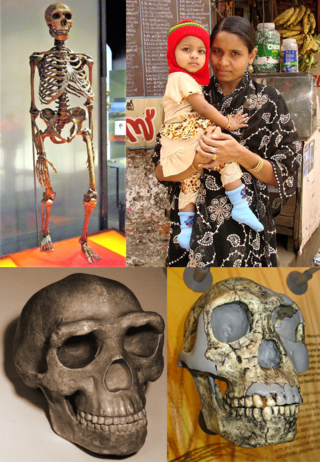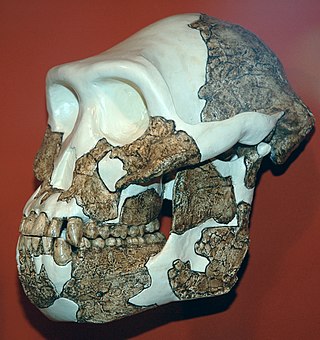Related Research Articles

Homo habilis is an extinct species of archaic human from the Early Pleistocene of East and South Africa about 2.8 million years ago to 1.65 million years ago (mya). Upon species description in 1964, H. habilis was highly contested, with many researchers recommending it be synonymised with Australopithecus africanus, the only other early hominin known at the time, but H. habilis received more recognition as time went on and more relevant discoveries were made. By the 1980s, H. habilis was proposed to have been a human ancestor, directly evolving into Homo erectus which directly led to modern humans. This viewpoint is now debated. Several specimens with insecure species identification were assigned to H. habilis, leading to arguments for splitting, namely into "H. rudolfensis" and "H. gautengensis" of which only the former has received wide support.

Australopithecus is a genus of early hominins that existed in Africa during the Pliocene and Early Pleistocene. The genera Homo, Paranthropus, and Kenyanthropus evolved from some Australopithecus species. Australopithecus is a member of the subtribe Australopithecina, which sometimes also includes Ardipithecus, though the term "australopithecine" is sometimes used to refer only to members of Australopithecus. Species include A. garhi, A. africanus, A. sediba, A. afarensis, A. anamensis, A. bahrelghazali and A. deyiremeda. Debate exists as to whether some Australopithecus species should be reclassified into new genera, or if Paranthropus and Kenyanthropus are synonymous with Australopithecus, in part because of the taxonomic inconsistency.

Donald Carl Johanson is an American paleoanthropologist. He is known for discovering, with Yves Coppens and Maurice Taieb, the fossil of a female hominin australopithecine known as "Lucy" in the Afar Triangle region of Hadar, Ethiopia.

Australopithecus afarensis is an extinct species of australopithecine which lived from about 3.9–2.9 million years ago (mya) in the Pliocene of East Africa. The first fossils were discovered in the 1930s, but major fossil finds would not take place until the 1970s. From 1972 to 1977, the International Afar Research Expedition—led by anthropologists Maurice Taieb, Donald Johanson and Yves Coppens—unearthed several hundreds of hominin specimens in Hadar, Ethiopia, the most significant being the exceedingly well-preserved skeleton AL 288-1 ("Lucy") and the site AL 333. Beginning in 1974, Mary Leakey led an expedition into Laetoli, Tanzania, and notably recovered fossil trackways. In 1978, the species was first described, but this was followed by arguments for splitting the wealth of specimens into different species given the wide range of variation which had been attributed to sexual dimorphism. A. afarensis probably descended from A. anamensis and is hypothesised to have given rise to Homo, though the latter is debated.

Homo is a genus of great ape that emerged from the genus Australopithecus and encompasses the extant species Homo sapiens and a number of extinct species classified as either ancestral to or closely related to modern humans, including Homo erectus and Homo neanderthalensis. The oldest member of the genus is Homo habilis, with records of just over 2 million years ago. Homo, together with the genus Paranthropus, is probably most closely related to the species Australopithecus africanus within Australopithecus. The closest living relatives of Homo are of the genus Pan, with the ancestors of Pan and Homo estimated to have diverged around 5.7-11 million years ago during the Late Miocene.
Paleoanthropology or paleo-anthropology is a branch of paleontology and anthropology which seeks to understand the early development of anatomically modern humans, a process known as hominization, through the reconstruction of evolutionary kinship lines within the family Hominidae, working from biological evidence and cultural evidence.
Hadar or Hadar Formation is a paleontological fossil site located in Mille district, Administrative Zone 1 of the Afar Region, Ethiopia, 15 km upstream (west) of the A1 road's bridge across the Awash River.

Australopithecus anamensis is a hominin species that lived approximately between 4.2 and 3.8 million years ago and is the oldest known Australopithecus species, living during the Plio-Pleistocene era.

Australopithecus garhi is a species of australopithecine from the Bouri Formation in the Afar Region of Ethiopia 2.6–2.5 million years ago (mya) during the Early Pleistocene. The first remains were described in 1999 based on several skeletal elements uncovered in the three years preceding. A. garhi was originally considered to have been a direct ancestor to Homo and the human line, but is now thought to have been an offshoot. Like other australopithecines, A. garhi had a brain volume of 450 cc (27 cu in); a jaw which jutted out (prognathism); relatively large molars and premolars; adaptations for both walking on two legs (bipedalism) and grasping while climbing (arboreality); and it is possible that, though unclear if, males were larger than females. One individual, presumed female based on size, may have been 140 cm tall.

The Gawis cranium is a portion of a fossil hominin skull discovered on February 16, 2006 near the drainage of Gawis, a tributary of the Awash River in the Afar Depression, Ethiopia. Despite the presence of volcanic ash layers that are key to dating, the cranium is only generally dated between 200,000 and 500,000 years ago due to taphonomic issues.

Yohannes Haile-SelassieAmbaye is an Ethiopian paleoanthropologist. An authority on pre-Homo sapiens hominids, he particularly focuses his attention on the East African Rift and Middle Awash valleys. He was curator of Physical Anthropology at the Cleveland Museum of Natural History from 2002 until 2021, and now is serving as the director of the Arizona State University Institute of Human Origins. Since founding the institute in 1981, he has been the third director after Donald Johanson and William Kimbel.

AL 129-1 is a fossilized knee joint of the species Australopithecus afarensis. It was discovered in Hadar, Ethiopia by Donald Johanson in November 1973.

AL 288-1, commonly known as Lucy or Dinkʼinesh, is a collection of several hundred pieces of fossilized bone comprising 40 percent of the skeleton of a female of the hominin species Australopithecus afarensis. It was discovered in 1974 in Ethiopia, at Hadar, a site in the Awash Valley of the Afar Triangle, by Donald Johanson, a paleoanthropologist of the Cleveland Museum of Natural History.

Selam (DIK-1/1) is the fossilized skull and other skeletal remains of a three-year-old Australopithecus afarensis female hominin, whose bones were first found in Dikika, Ethiopia in 2000 and recovered over the following years. Although she has often been nicknamed Lucy's baby, the specimen has been dated at 3.3 million years ago, approximately 120,000 years older than "Lucy".

Zeresenay "Zeray" Alemseged is an paleoanthropologist who is a faculty member at the University of Chicago. In 2013, he was named a Fellow of the American Association for the Advancement of Science. He was elected to the American Academy of Arts & Sciences in 2021. In 2022, he was appointed to the Comité Scientifique International du Musée d’Anthropologie Préhistorique de Monaco and the Pontifical Academy of Science. Alemseged is best known for his discovery, on 10 December 2000, of Selam, also referred to as the "Dikika child" or “Lucy’s child”, the almost-complete fossilized remains of a 3.3 million-year-old child of the species Australopithecus afarensis. The “world’s oldest child”, she is the most complete skeleton of a human ancestor discovered to date. Selam represents a milestone in understanding of human and pre-human evolution and contributes significantly to understanding of the biology and childhood of early species in the human lineage; a subject about which we have very little information. Alemseged discovered Selam while working with the Dikika Research Project (DRP), a multi-national research project funded in part by the National Science Foundation, which he both initiated in 1999 and leads. The DRP has thus far made many important paleoanthropological discoveries and returns to the field each year to conduct further important research. Alemseged's specific research centers on the discovery and interpretation of hominin fossil remains and their environments, with emphasis on fieldwork designed to acquire new data on early hominin skeletal biology, environmental context, and behavior.
The Dikika is an area of the Afar Region of Ethiopia. A hominin fossil named Selam, a specimen of the Australopithecus afarensis species, was found in this area. Papers also propose the earliest evidence of stone tool use at this site in the form of cut marks on animal bone. However there has been argument about this proposal. Dikika is located in Mille woreda.
Pinnacle Point a small promontory immediately south of Mossel Bay, a town on the southern coast of South Africa. Excavations since the year 2000 of a series of caves at Pinnacle Point have revealed occupation by Middle Stone Age people between 170,000 and 40,000 years ago. The focus of excavations has been at Cave 13B (PP13B), where the earliest evidence for the systematic exploitation of marine resources (shellfish) and symbolic behaviour has been documented, and at Pinnacle Point Cave 5–6 (PP5–6), where the oldest evidence for the heat treatment of rock to make stone tools has been documented. The only human remains have been recovered from younger deposits at PP13B which are c. 100,000 years old.
AL 333, commonly referred to as the "First Family", is a collection of prehistoric hominid teeth and bones. Discovered in 1975 by Donald Johanson's team in Hadar, Ethiopia, the "First Family" is estimated to be about 3.2 million years old, and consists of the remains of at least thirteen individuals of different ages. They are generally thought to be members of the species Australopithecus afarensis. There are multiple theories about the hominids' cause of death and some debate over their species and sexual dimorphism.

Ledi-Geraru is a paleoanthropological research area in Mille district, Afar Region, northeastern Ethiopia, along the Ledi and Geraru rivers. It stretches for about 50 km, located just to the northeast of the Hadar paleoanthropological area.
William "Bill" Kimbel was a paleoanthropologist specializing in Plio-Pleistocene hominid evolution in Africa. He had a multi-decade career at Arizona State University, first as a professor in the Anthropology Department and then as the Director of the Institute of Human Origins and Virginia M. Ullman Professor of Natural History and the Environment in the School of Human Evolution and Social Change.
References
- ↑ "About IHO". Institute of Human Origins. Arizona State University. Retrieved 9 April 2016.
- ↑ "Institute of Human Origins" (PDF). May 1997. Archived from the original (PDF) on 2015-09-20. Retrieved 2016-04-08.
- ↑ "IHO Research Council (2016-2017)". Archived from the original on 2016-04-19.
- ↑ "Institute of Human Origins" (PDF). May 1997. Archived from the original (PDF) on 2015-09-20. Retrieved 2016-04-08.
- ↑ "ASU institute receives single-largest investment in human origins research". EurekAlert: The Global Source for Science News. American Association for the Advancement of Science. 17 September 2014. Retrieved 8 April 2016.
- ↑ "ASU institute receives single-largest investment in human origins research". Arizona State University.
- ↑ Rothman, Lily (24 November 2015). "How Lucy the Australopithecus Changed the Way We Understand Human Evolution". Time. Time Magazine. Retrieved 9 April 2016.
- ↑ "Ancient Jawbone Could Shake Up Fossil Record". National Geographic. Archived from the original on August 11, 2007.
- 1 2 Bryn, Brandon (4 March 2015). "Oldest Fossil of Homo Genus Found in Ethiopia". American Association for the Advancement of Science. Archived from the original on 15 March 2015.
{{cite web}}: CS1 maint: unfit URL (link) - ↑ "Discovery of 2.8-million-year-old jaw sheds light on early humans Date". Science Daily.
- ↑ "Hadar Paleoanthropology Field School" . Retrieved 9 April 2016.
- 1 2 Hirst, K. Kris. "Pinnacle Point [PP13B] (South Africa)". Archived from the original on 2017-02-10. Retrieved 2016-04-09.
- ↑ "Heat Treatment Makes Better Stone Tools". Becoming Human.
- ↑ Marean, Curtis; Bar-Matthews, M; Bernatchez, J; Fisher, E; Goldberg, P (2007). "Early human use of marine resources and pigment in South Africa during the Middle Pleistocene" (PDF). Nature. 449 (7164): 905–U11. Bibcode:2007Natur.449..905M. doi:10.1038/nature06204. PMID 17943129. S2CID 4387442.
- ↑ "IHO Templeton Research Program" . Retrieved 9 April 2016.
- ↑ "Research Faculty | Institute of Human Origins". iho.asu.edu. Retrieved 2023-11-02.
- ↑ "Member Search".